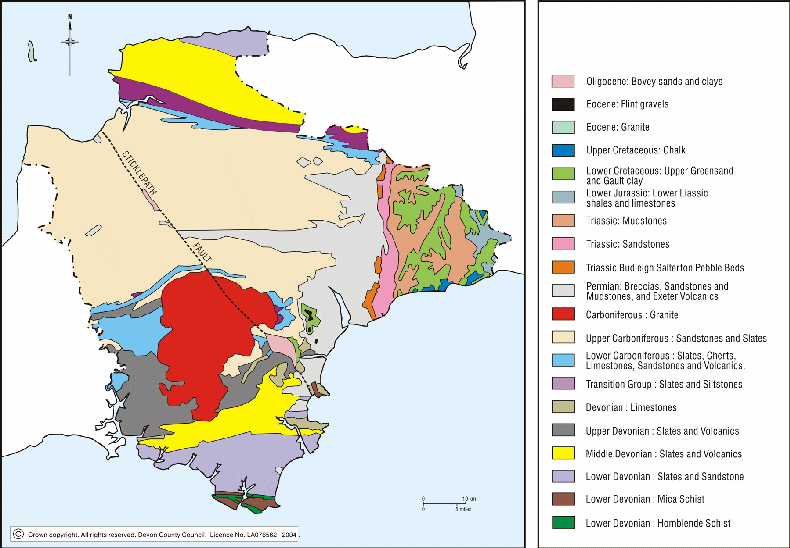
|
|
Devon’s geology is one of the most varied in the British Isles and this is reflected in the great variety of its landscapes. The county records around 415 million years of Earth history and is particularly distinguished by being the only one in the British Isles to give its name to an interval of geological time of world-wide recognition - the Devonian.
Summary Map of the Geology of Devon
Source: DCC (2004), ‘Devon County Minerals Local Plan’

Basic Description of the Geology of Devon
|
Devonian rocks, dating from between 415 and 360 million years ago are the oldest rocks found in the county and represent a time when Devon was under the sea near the equator. Sandstones and shales were deposited at this time and can now be found in both north and south Devon. Also, limestone formed in areas of shallow waters, which can be seen now around Plymouth and Torquay. |
|
|||
|
|
Towards the end of the Devonian period and into the Carboniferous time period, Devon’s rocks were part of a (now vanished) chain of mountains. Intense squeezing and folding created the spectacular structures we can see along the north Devon coast today. The uplands of Devon are dominated by the granite of Dartmoor which moved up into the folded rocks during the formation of the mountains. |
|||
|
After the folding, faulting and mountain building, Devon entered a long hot arid period between 300 and 200 million years ago. This covers two geological periods known as the Permian and Triassic. The climate was like that of the Sahara Desert today. Seasonal flash floods swept large quantities of sediment into the valleys and the plains fringing the deserts and both the red mudstone and the Pebble Beds found in east Devon are classic examples of such deposition. Devon also featured volcanoes at this time. The lava erupted form the deposits found around Exeter, known as the Exeter Volcanic Series. |
|
|||
|
|
At the end of the Triassic time period, the sea level rose and tropical seas flooded the deserts. This marks the start of the Jurassic geological period (between 200 and 145 million years ago). The rocks which date from this time form the dramatic Jurassic Coast in east Devon, internationally recognised as a World Heritage Site. The cliffs within the Jurassic Coast record 185 million years of the Earth’s history in just 95 miles because the rocks tilt or ‘dip’ down under the sea to the east. Therefore the oldest rocks, at 250 million years in age, are found in the west and younger rocks form the cliffs to the east. These rocks contain important fossils which document the dinosaurs which swam in the seas covering Devon. From the sea, white chalk was deposited across the county of Devon.
|
|||
|
In the geological history of the Jurassic Coast there is also a "Great Unconformity" or time gap between the rocks of different ages. About 100 million years ago, in the middle of the Cretaceous geological time period, the rocks were in the process of tilting eastwards and were heavily eroded by seas and rivers, especially in the west of the area. As a result, chalk only occurs in parts of east Devon, due to the extensive erosion, but hard flint gravels derived from the chalk are scattered across the county. With a jump in geological time, Devon also contains some younger geological features, namely ball clay deposits and Lundy granite. These date from the Tertiary geological time period and are aged between 65 and 2.5 million years old. Lundy granite was originally thought to be the same age as Devon’s Dartmoor granite, however, radiometric dating showed that it was much younger. The ball clay found in the county was deposited in basins formed by subsidence along the Sticklepath Fault, which crossed the whole of Devon. The youngest rocks of Devon date from the Quaternary geological time period, which represents rocks dated from 2.5 million years ago to today. The major geological event of this time was a succession of ice ages. There is no record of Devon being covered in glaciers, but permafrost conditions which created a wide range of periglacial features and deposits. Fluvial and coastal processes in these conditions created important landforms and other distinct features.
For further information on the geology of Devon and a review of plans, policies, programmes and sustainability objectives, click on the link below: http://www.devon.gov.uk/mcs-geodiversity.pdf
Illustrations of palaeo-environments © Devon County Council |
||||